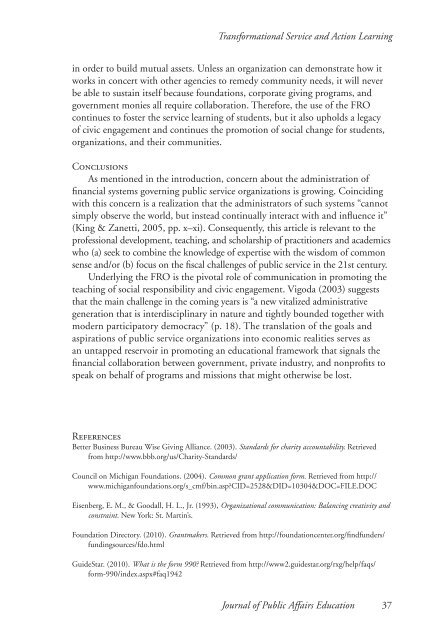Journal of Public Affairs Education
You also want an ePaper? Increase the reach of your titles
YUMPU automatically turns print PDFs into web optimized ePapers that Google loves.
Transformational Service and Action Learning<br />
in order to build mutual assets. Unless an organization can demonstrate how it<br />
works in concert with other agencies to remedy community needs, it will never<br />
be able to sustain itself because foundations, corporate giving programs, and<br />
government monies all require collaboration. Therefore, the use <strong>of</strong> the FRO<br />
continues to foster the service learning <strong>of</strong> students, but it also upholds a legacy<br />
<strong>of</strong> civic engagement and continues the promotion <strong>of</strong> social change for students,<br />
organizations, and their communities.<br />
Conclusions<br />
As mentioned in the introduction, concern about the administration <strong>of</strong><br />
financial systems governing public service organizations is growing. Coinciding<br />
with this concern is a realization that the administrators <strong>of</strong> such systems “cannot<br />
simply observe the world, but instead continually interact with and influence it”<br />
(King & Zanetti, 2005, pp. x–xi). Consequently, this article is relevant to the<br />
pr<strong>of</strong>essional development, teaching, and scholarship <strong>of</strong> practitioners and academics<br />
who (a) seek to combine the knowledge <strong>of</strong> expertise with the wisdom <strong>of</strong> common<br />
sense and/or (b) focus on the fiscal challenges <strong>of</strong> public service in the 21st century.<br />
Underlying the FRO is the pivotal role <strong>of</strong> communication in promoting the<br />
teaching <strong>of</strong> social responsibility and civic engagement. Vigoda (2003) suggests<br />
that the main challenge in the coming years is “a new vitalized administrative<br />
generation that is interdisciplinary in nature and tightly bounded together with<br />
modern participatory democracy” (p. 18). The translation <strong>of</strong> the goals and<br />
aspirations <strong>of</strong> public service organizations into economic realities serves as<br />
an untapped reservoir in promoting an educational framework that signals the<br />
financial collaboration between government, private industry, and nonpr<strong>of</strong>its to<br />
speak on behalf <strong>of</strong> programs and missions that might otherwise be lost.<br />
References<br />
Better Business Bureau Wise Giving Alliance. (2003). Standards for charity accountability. Retrieved<br />
from http://www.bbb.org/us/Charity-Standards/<br />
Council on Michigan Foundations. (2004). Common grant application form. Retrieved from http://<br />
www.michiganfoundations.org/s_cmf/bin.asp?CID=2528&DID=10304&DOC=FILE.DOC<br />
Eisenberg, E. M., & Goodall, H. L., Jr. (1993), Organizational communication: Balancing creativity and<br />
constraint. New York: St. Martin’s.<br />
Foundation Directory. (2010). Grantmakers. Retrieved from http://foundationcenter.org/findfunders/<br />
fundingsources/fdo.html<br />
GuideStar. (2010). What is the form 990? Retrieved from http://www2.guidestar.org/rxg/help/faqs/<br />
form-990/index.aspx#faq1942<br />
<strong>Journal</strong> <strong>of</strong> <strong>Public</strong> <strong>Affairs</strong> <strong>Education</strong> 37



